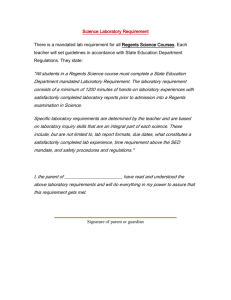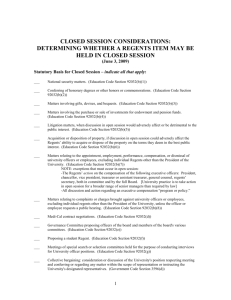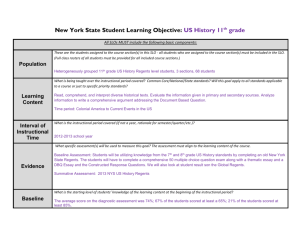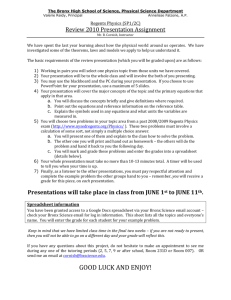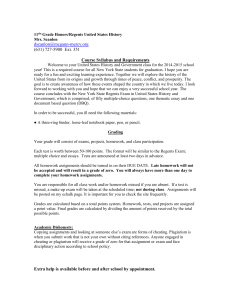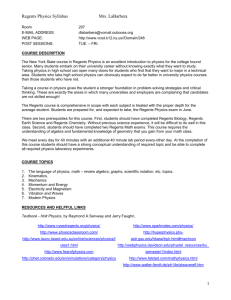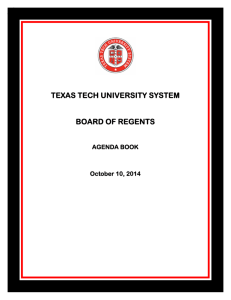Why Should I teach for Social Justice?
advertisement
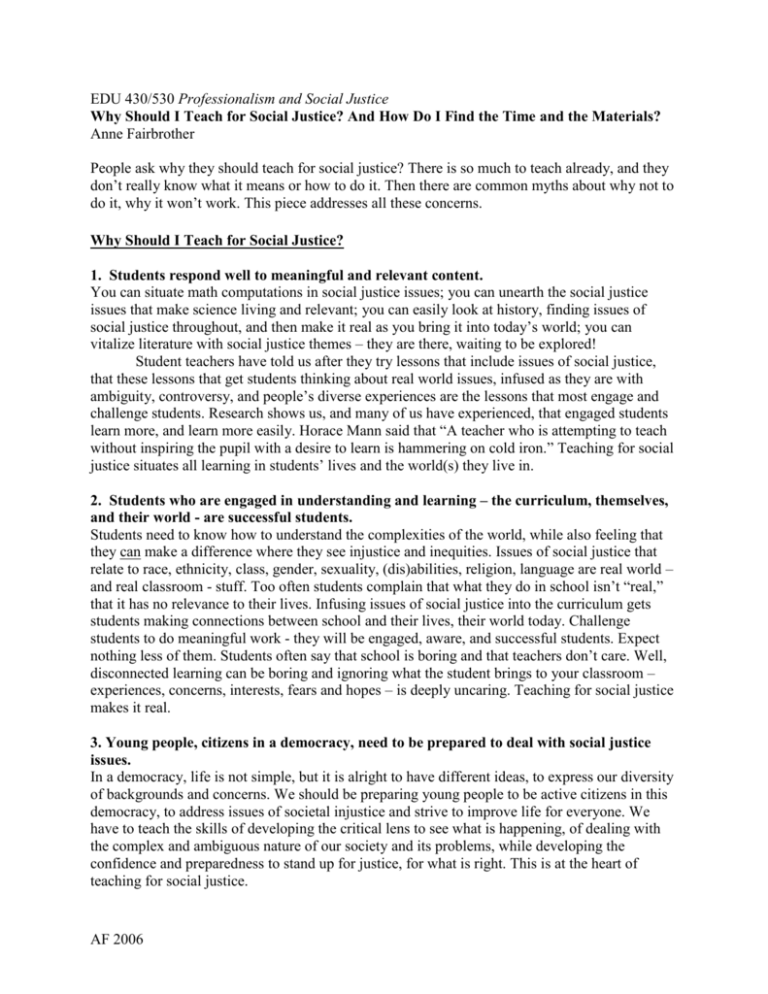
EDU 430/530 Professionalism and Social Justice Why Should I Teach for Social Justice? And How Do I Find the Time and the Materials? Anne Fairbrother People ask why they should teach for social justice? There is so much to teach already, and they don’t really know what it means or how to do it. Then there are common myths about why not to do it, why it won’t work. This piece addresses all these concerns. Why Should I Teach for Social Justice? 1. Students respond well to meaningful and relevant content. You can situate math computations in social justice issues; you can unearth the social justice issues that make science living and relevant; you can easily look at history, finding issues of social justice throughout, and then make it real as you bring it into today’s world; you can vitalize literature with social justice themes – they are there, waiting to be explored! Student teachers have told us after they try lessons that include issues of social justice, that these lessons that get students thinking about real world issues, infused as they are with ambiguity, controversy, and people’s diverse experiences are the lessons that most engage and challenge students. Research shows us, and many of us have experienced, that engaged students learn more, and learn more easily. Horace Mann said that “A teacher who is attempting to teach without inspiring the pupil with a desire to learn is hammering on cold iron.” Teaching for social justice situates all learning in students’ lives and the world(s) they live in. 2. Students who are engaged in understanding and learning – the curriculum, themselves, and their world - are successful students. Students need to know how to understand the complexities of the world, while also feeling that they can make a difference where they see injustice and inequities. Issues of social justice that relate to race, ethnicity, class, gender, sexuality, (dis)abilities, religion, language are real world – and real classroom - stuff. Too often students complain that what they do in school isn’t “real,” that it has no relevance to their lives. Infusing issues of social justice into the curriculum gets students making connections between school and their lives, their world today. Challenge students to do meaningful work - they will be engaged, aware, and successful students. Expect nothing less of them. Students often say that school is boring and that teachers don’t care. Well, disconnected learning can be boring and ignoring what the student brings to your classroom – experiences, concerns, interests, fears and hopes – is deeply uncaring. Teaching for social justice makes it real. 3. Young people, citizens in a democracy, need to be prepared to deal with social justice issues. In a democracy, life is not simple, but it is alright to have different ideas, to express our diversity of backgrounds and concerns. We should be preparing young people to be active citizens in this democracy, to address issues of societal injustice and strive to improve life for everyone. We have to teach the skills of developing the critical lens to see what is happening, of dealing with the complex and ambiguous nature of our society and its problems, while developing the confidence and preparedness to stand up for justice, for what is right. This is at the heart of teaching for social justice. AF 2006 How Can I Teach for Social Justice? As the lesson plans and lesson ideas that fill this course pack show, there are ways to infuse teaching for social justice into all content areas, all grade levels. It should not be an add-on, but rather infused through your teaching, your stance as a teacher, their stance as young learners of life. It is high school teachers who most often ask how they can have the time to fit in “social justice” with all the constraints of the curriculum. But you can teach the content, the academic and critical thinking, while teaching for social justice! Preparing students for the high school English and Social Studies Regents (just looking at these two areas here) can include addressing issues of social justice throughout the courses – in fact, the nature of the thinking called for, says that such courses should include such a focus. English Language Arts. The Regents exams test students’ abilities to read and make meaning of texts. The most recent Regents (June 2006) asked students in Session One to read an essay on acid rain and derive their understanding, make connections, and draw conclusions. Students can work with engaging, relevant essays on social justice issues to develop such literacy skills. For example: discussions of gender stereotypes and inequities; issues of racism through history and in local communities; divergent arguments over immigration, migrant labor; issues of gay marriage, English only ordinances, (dis)ability rights. These can be explored in literature, in historical contexts, as current events. From such informed readings students can make connections to their lives, develop informed opinions, argue their ideas, create plans of action. In Session Two, June 2006, students are asked to address a “big idea” about identity, ethics, character… and to talk about two books in illustration of their opinion. Students can read multicultural works and do the same kind of thinking and analysis as they can with canonical texts, and they can find social justice issues in many of the novels traditionally taught in high schools. The prompt in this Exam was from Dr. Martin Luther King, easily raising social justice issues! Students who have thought about these issues throughout the year will be the best prepared to address them: “The ultimate measure of a man [sic] is not where he stands in moments of comfort and convenience, but where he stands at times of challenge and controversy.” (MLK Jr., Strength to Love, 1963) Social Studies. The Regents Examinations test students’ ability to look deeply at events and synthesize information and interpretations. The Thematic Essay requirement prompt (Part II) in the June 2006 Examination was: “Major historical events are often referred to as turning points because they have led to important political, social, and economic changes.” The students are asked to identify and describe two major events in U. S. history that were important turning points and look at the political, social, and economic changes that resulted. Students who have looked at U. S. History through the lens of social justice have explored the tensions, conflicts, triumphs and frustrations for people through U. S. history, and are well prepared to address this topic. Civil Rights Issues is one of the suggested topics AF 2006 given. We want our students to talk about these things and the Regents Examinations call for such developed thinking. In Part III of the June 2006 exam, The Document-Based Question (DBQ) prompt asks students to synthesize the role of mass media in the U.S. since 1900, giving them relevant primary documents that look at socio-historical events that involved mass media. Using primary documents allows for voices of oppression and marginalization to be heard and allows students to look at history from multiple perspectives. All good preparation for rich informed interpretations of moments in U. S. history. Myths About Teaching 1. “Students in the lower tracks aren’t interested in doing school work.” They will if they perceive it as relevant and if they are challenged. Indeed, research shows, and many of us have experienced, that students disengage because what they are being asked to do is not interesting or relevant to their lives. No student likes being bored – remember that! Students are often in lower tracks because they aren’t engaged in school. When students are asked what isn’t boring, they tell us it is being challenged, being asked to think, find out for themselves, being engaged in real-world issues and materials. They will engage if you make it real. 2. “I don’t have time in Honors and Regents classes to teach for social justice.” The Regents exams require critical thinking: the ability to look at times of change in history from multiple perspectives; the aptitude to analyze literature (multicultural literature can be taught, specific texts are not prescribed by the Regents) and deal with the big ideas; science and math concepts are better understood if contextualized, and students learn more quickly and do better on the tests if they understand and care about the material. Social Justice issues permeate and inform history and literature, bring science from the lab into the world, and give a reason for knowing and doing math. 3. “There are no materials for me to use.” In this packet you will find an abundance of resources from books to web links to lesson plans. We have included lessons and ideas for lessons, resources, places to start your own exploration for materials and ideas. It will take work and time, but you will transform your teaching and the experiences of your students as a result. So, how can you NOT include social justice in your teaching? AF 2006

